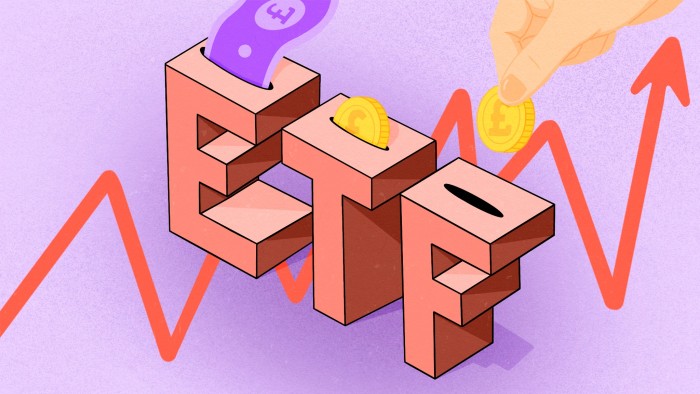Go on the defensive: ETFs for a volatile market


Roula Khalaf, Editor of the FT, selects her favourite stories in this weekly newsletter.
Risk levels are on the rise and stock market volatility is set to surge, according to some fund managers. In recent weeks, two defensive investment trusts — Capital Gearing and Ruffer Investment Company, both beloved of private investors — have warned about a long list of risks. These include more inflation to come, impending recessions, liquidity squeezes and the obligatory “geopolitical risk”.
I have no idea whether these experienced and respected managers are right, but one measure of stock market volatility — the Vix index, which tracks US benchmark turbulence — is well below its long-term average. Then again, volatility has a nasty habit of erupting and making fools of those who said market turbulence was nothing to worry about.
A cynic might suggest the reason that fund managers warn of impending doom is that they quite like these markets. They can show off their active manager skills — that is, superior stock picking and asset allocation.
Frankly, if you can save investors from a nasty market correction — in the range of 10 to 20 per cent — you can almost write your own cheque in terms of fees. This, in turn, feeds the myth that active managers are better at risk control in more turbulent markets, while passive funds lead their investors lemming-like towards a market drubbing.
It’s a “myth” because there is no hard evidence that active managers are any better at coping with more turbulent markets. Most fail to beat the benchmark most of the time. That’s true even during more turbulent markets.
Investors naturally gravitate towards more defensive ideas and strategies in times of heightened market concern. The good news is that among passive funds — and especially in the world of ETFs — there are useful product ideas surfacing.
Let’s start with the idea of investing in equities but with a skew towards dividend-rich stocks — an “equity income” strategy. Studies over many decades show that the contribution of dividends to total returns makes a huge difference, along with their subsequent reinvestment.
It is also true that dividends are less prone to volatility than other forms of return. However, a recent paper by ETF firm Wisdom Tree looked at the decade-by-decade contribution of dividends to total returns for companies in the US’s S&P 500. They reckon that over the long term these payouts contributed almost 30 per cent to the 10.4 per cent annual total returns from the index.
Naturally, they have a successful product in this field — the WisdomTree Global Quality Dividend Growth UCITS ETF (ticker GGRG). This focuses on those stocks with a more-than-decent dividend, where dividend growth from increased profits is likely.
I recently tested this ETF against many of its more expensive, actively managed peers and found that, by and large, it outperformed them. There is now real competition in equity income ETFs, notably from another firm with roots in the US: a rival product is called the VanEck Morningstar Developed Markets Dividend Leaders UCITS ETF (ticker TDIV).
This kind of ETF is much less focused on US equities — with exposure well under 30 per cent — than more mainstream global equity indices. For typical mainstream products, the figure is well over 60 per cent.
Valuations for the underlying stocks are much less challenging as well, with the average price-to-earnings ratio under 10 and the price-to-book ratio closer to one. The current dividend yield is running at a shade over 4.5 per cent.
Another strategy worth investigating is “covered call ETFs”. In the US these are hugely popular with private investors, with more than $30bn invested in more than a dozen funds, including a very successful ETF from JPMorgan.
In simple terms, these funds invest in the stocks of a mainstream index such as the S&P 500 and then deliver an additional steady call option “premium” income. That is, the stock holdings are used to generate call-option premiums. The premium received from selling the call option provides additional income for the investor and can either be paid out as straight income or partially reinvested.
The idea here is that you give up some of the potential upside from equities for options income. That means you’ll lose out in a rampant bull market. You’ll also see losses in a market collapse, though probably at a lower level than a classic benchmark index. The upside is that all that income from call-option writing does help smooth out returns and damp volatility.
Covered call funds are not new in the UK funds market. One version was pioneered by Schroders via its Income Maximiser range, which includes a very popular UK fund as well as US and Asian variants.
ETF issuers in Europe have embraced the idea, notably another firm with US origins, Global X. It recently launched a fund that tracks the S&P 500 — the Global X S&P 500 Covered Call UCITS ETF (XYLU LN) — and a sister fund which tracks the Nasdaq 100 — The Global X Nasdaq 100 Covered Call UCITS ETF (QYLD LN).
In both cases, the fund caps monthly distributions at half of the premiums received or 1 per cent of the fund’s net asset value, with any excess premiums reinvested. It looks like the underlying options yield (and any dividends from companies) has been running at around 12 per cent a year, although in more volatile markets that can shoot up closer to 20 per cent.
Global X has also launched an even more defensive strategy: buffer ETFs. The Global X S&P 500 Quarterly Buffer UCITS ETF (SPQB LN) will track a version of the US benchmark up to a cap of about 15 per cent on the upside, while also protecting investors against the first 5 per cent of losses each quarter.
These are in effect stock market-listed structured products and it is worth noting that in the UK traditional structured products — usually called kick-out plans — have become very popular, producing impressive returns over the past decade or so.
I’ll finish my quick spin through defensive ETFs with a mention of two bond ideas. I’ve become increasingly convinced that we have reached peak interest rates for now. For me, that means long-duration government bonds are becoming increasingly interesting.
You can buy individual UK government bonds — gilts — but it’s more difficult to buy US Treasury bonds. This is where an iShares ETF comes in — the USD Treasury Bond 20+yr UCITS ETF GBP Hedged (IDTG). This is a tracker fund that’s hedged against the dollar. In other words it is a way of buying that long end of the US Treasury bond curve in an ETF format.
In recent years this has been a truly awful investment, but its time may have come, as US investors have become more and more convinced about the likely future downward trajectory of US interest rates. I think there’s a real possibility of capital upside if long bond yields do decline. In the meantime, the weighted average yield to maturity is at around 4.7 per cent a year.
David Stevenson is an active private investor. Email: adventurous@ft.com. Twitter: @advinvestor.
Comments